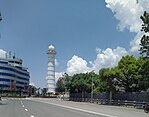Nidayar City
Nidayar | |
|---|---|
Regional capital | |
| Nidayar Metropolitan City | |
|
Clockwise from top: Nidayar Skyline, Phantaghar, Rarahara, Lashupatinath Temple, Tamal Pokhari, Rani Tokhari | |
| Country | |
| Province | Nidayar |
| Area | |
| • Regional capital | 49.45 km2 (19.09 sq mi) |
| • Metro | 899 km2 (347 sq mi) |
| Elevation | 1,400 m (4,600 ft) |
| Population | |
| • Regional capital | 856,767 |
| • Metro | 2.9 million |
Nidayar, otherwise known as Nidayar City, is the regional capital and most-populous city of the Haduastani-administered territory of Nidayar with 845,767 inhabitants and 2.9 million people in its urban agglomeration. It is located in the Nidayar Valley, a large valley in the high plateaus in central Nidayar, at an altitude of 1,400 metres (4,600 feet). The city is one of the oldest continuously inhabited places in the world, founded in the 2nd century AD. The valley was historically the home of the Tujti people, a cosmopolitan urban civilization in the Nidayar foothills. The city was the royal capital of the Kingdom of Nidayar and hosts palaces, mansions and gardens built by the Nidayari aristocracy. Nidayar is and has been for many years the centre of southern Haduastan's history, art, culture, and economy. It has a multi-ethnic population within a Haduan and Buddhist majority. Religious and cultural festivities form a major part of the lives of people residing in Nidayar. Prior to the 2023 Nidayar War, it was one of the fastest-growing metropolitan areas in Central Ausiana. During the war, the city was heavily damaged the fighting and hundreds of thousands were forced to flee, creating a refugee crisis.





